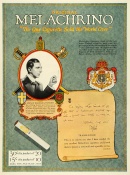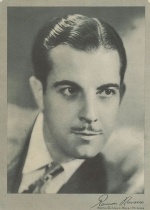Difference between revisions of "Chapter 19"
(→Page 137) |
(→Page 132) |
||
| Line 5: | Line 5: | ||
[[image:Melachrino-cigarettes.jpg|thumb|130px|'''Melachrino Ad'''|right]]'''"smoking a Melachrino in a jade holder"'''<br /> | [[image:Melachrino-cigarettes.jpg|thumb|130px|'''Melachrino Ad'''|right]]'''"smoking a Melachrino in a jade holder"'''<br /> | ||
Melachrino cigarettes — "the aristocratic Egyptian cigarette" — were an Egyptian brand popular from the late 19th century through mid-20th century. In its advertising it emphasized Orientalism (romanticizing "the East"), worldliness and sophistication, and high-class leisure (opera, hotels, international travel). | Melachrino cigarettes — "the aristocratic Egyptian cigarette" — were an Egyptian brand popular from the late 19th century through mid-20th century. In its advertising it emphasized Orientalism (romanticizing "the East"), worldliness and sophistication, and high-class leisure (opera, hotels, international travel). | ||
| + | |||
| + | '''Glow Tripforth del Vasto'''<br /> | ||
| + | This character's name is very similar to [https://gravitys-rainbow.pynchonwiki.com/wiki/index.php?title=T#geli Geli (pronounced "gaily") Tripping in ''Gravity's Rainbow''']. Both " to trip forth" and "gaily tripping" mean to move lightly, happily, and with a dancing or skipping step. In ''GR'', Geli Tripping is a young woman who thinks she's a witch and was lovers both to Tchitcherine and Slothrop. | ||
==Page 133== | ==Page 133== | ||
Revision as of 17:08, 13 November 2025
Contents
Page 132
"ocean liner Stupendica"The S.S. Stupendica makes an appearance in Pynchon's Against the Day, being the liner the Zombini family takes to Europe for a tour. Discussion
"smoking a Melachrino in a jade holder"Melachrino cigarettes — "the aristocratic Egyptian cigarette" — were an Egyptian brand popular from the late 19th century through mid-20th century. In its advertising it emphasized Orientalism (romanticizing "the East"), worldliness and sophistication, and high-class leisure (opera, hotels, international travel).
Glow Tripforth del Vasto
This character's name is very similar to Geli (pronounced "gaily") Tripping in Gravity's Rainbow'. Both " to trip forth" and "gaily tripping" mean to move lightly, happily, and with a dancing or skipping step. In GR, Geli Tripping is a young woman who thinks she's a witch and was lovers both to Tchitcherine and Slothrop.
Page 133
junior purser
This would be an assistant to the purser on an ocean liner who was the ship’s chief administrative and financial officer — essentially the head of the ship’s hotel, passenger, and business operations, while the captain handled navigation and command.
Page 134
"furtive Ronald Colman faces"
The on-screen characters played by English actor Ronald Colman (1891-1958) could be described as quiet, elegant, and inward. He projected cultivated restraint: a man of gentle intelligence, lightly ironic charm, and emotion held just beneath the surface. Even in dramatic moments, he remained composed, conveying depth through voice, posture, and a faint, private sadness rather than overt display.
Possibly a likely nod to the Spanish zarzuela (a Spanish traditional form of musical comedy) Las Hijas del Zebedee by Ruperto Chapí (score) and Miguel Ramos Carrión & Vital Azain (libretto). The plot:
Coral and Candelas, the daughters of Zebedeo, are clever and self-assured young women in a small town. A vain would-be ladies’ man named Porfirio arrives, convinced of his own irresistible charm, and tries to woo them with flowery speeches and theatrical self-pity. The sisters see straight through him and, with humor and intelligence, turn his pretensions into comedy. Other men in town respond with jealousy, offering gifts and grand gestures to try to "win" the sister'’ loyalty, but the women show that affection cannot be bought or claimed by vanity. The story ends with harmony restored, the men gently humbled, and the sisters firmly in control of their own choices.
This is the birth of the “Porfirio” type: a preening, self-deluded romantic who believes his own theatrics.
This is also the exact structure that later allows "Porfirio" to become slang — in Chicago, NYC, Buenos Aires, Havana, Naples, Marseille — for a vain lounge-lizard gigolo type.
"now the big sap wants to give me an autogyro"
an early type of rotary-wing aircraft invented in the 1920s by the Spanish engineer Juan de la Cierva. It looks a bit like a small airplane with a free-spinning rotor on top. (Also, p. 139)
January 1929, Popular Mechanics ran one of the first U.S. popular press features on Juan de la Cierva’s autogyro (or autogiro). Cierva designed a series of increasingly capable autogiros in the early 1930s which were put into small-scale production by several aircraft manufacturers. The magazine continued to feature the planes throughout the years.
Gaudeamus igitur
The opening line of a medieval student drinking song that became the traditional university graduation song across Europe. The full title is usually Gaudeamus Igitur, Juvenes Dum Sumus ("Let us rejoice, therefore, while we are young.")
Page 135
'Sticky—Toffee—Pud-ding?'
Sticky Toffee Pudding is a classic British dessert: a warm, moist date cake soaked in a buttery toffee sauce, usually served with vanilla ice cream, custard, or clotted cream. It’s rich, comforting, and not difficult to make. A dessert with this name wasn't offered in America of the 1930s and was only beginning to be offered in the U.K.
"a chop house called St. Hubert's..."
St. Hubert’s Chop House was a well-known Chicago Loop restaurant in the 1920s and 1930s, located at 22 West Randolph Street, just west of State Street, in what was then the very center of the theater-and-hotel district. It was part of the old-style "chop house" tradition: dark wood, leather booths, heavy meals, and a clientele of salesmen, newspapermen, brokers, and political fixers.
"your Mr. Dawes, savior of the German economy"
Refers to Charles G. Dawes (1865–1951), Chicago banker, brigadier general in WWI, later Vice President under Coolidge, and, most importantly in this context, the architect of the 1924 Dawes Plan, devised to rescue the collapsed German economy after World War I, for which he received the 1925 Nobel Peace Prize.
Union League Club
The Union League Club of Chicago, founded in 1879, is and was one of the city’s most historically significant private civic clubs, a pillar of the Reform Republican / business-civic elite since the late 19th century. Members historically included bank presidents,federal judges, railroad and utilities executives, university trustees, senior lawyers, philanthropists, military officers. This is the world of Charles G. Dawes
"Republicans and gangsters? How can such a thing be?"...
Heh heh.
Page 136
"Mr. Guzik did happen to mention his role in helping with [...] the Dawes Plan"Both Guzik and Dawes operated in the same Chicago power structure, but at different tiers — Dawes in high finance, international stabilization, banker-politician, and Guzik in street-level political influence, bribery networks, gangster patronage. But both relied on the same machine: Chicago aldermanic control; police patronage system; ward organizations; and Commercial corridors tied to city contracting. The Dawes Plan pumped foreign capital through Chicago banks, expanding real estate mortgage credit, commercial construction, street and transit development contracts, and public utility finance. Guzik, meanwhile, controlled the political gatekeepers who steered permits, inspections, and union access on those same projects.
"Alf expects a "Great Simplification" quite soon..."
The phrase "Great Simplification" in the 1930s refers to the widespread design and cultural shift away from ornament, fuss, and excess toward clean lines, functional forms, and visual clarity, in industrial design, architecture, advertising / product styling, and interior and graphic design. The term appears in trade journals, design lectures, and popular magazines (including Fortune, Architectural Forum, and House & Garden) beginning around 1930–1932, especially after the stock market crash, when extravagance looked not only old-fashioned but socially tone-deaf.
Page 137
"Now, none of that Pip Emma, you damned flirt,"
"Pip" is a diminuitive of "Philippa," so perhaps Philippa's middle name is Emma? Or maybe a nod to the military signallers' phonetic alphabet for the letters "P" and "M" ("Pip Emma"), meaning "post meridiem" or "in the afternoon."
Page 138
"Things been a little slow, Gingersnap...?"
"Gingersnap" as slang for a girl appears in the 1910s–1930s, meaning a lively, cute, spirited, slightly cheeky young woman. It’s affectionate, playful, and a little flirtatious but never insulting.
In the 1930s, Ramon Novarro transitioned from a leading silent film star to navigating the challenges of sound films, a period that saw both success and the beginning of his career's decline. He starred in the popular Greta Garbo film Mata Hari (1931) but found his leading roles became scarce as he was often cast in exotic "Latin" roles.
"taking chances with their personal safety that would make Harold Lloyd think twice"
Harold Clayton Lloyd Sr. (1893-1971) was an American actor, comedian, and stunt performer who appeared in many silent comedy films, and he took extraordinary risks with his personal safety. Unlike Buster Keaton or Chaplin, he often did his dangerous stunts without a full safety net and after suffering an injury that should have ended his physical career. Just one example: In 1919, while posing for publicity photographs, Lloyd picked up what he thought was a prop bomb. But it was real, exploding in his hand and blowing off his right thumb and forefinger, burning the side of his face, and nearly blinding him.
Page 139
"Forest Home or Pilgrim's Rest"
A couple well known cemeteries in Wisconsin, Forest Home being located in Milwaukee and Pilgrims Rest located in Monroe County. I believe "Pilgrim's" is a misspelling as there's no apostrophe.
"La Gloriosa refuses to accept a centavo"
Given Pynchon's penchant for opera, in the late 19th on into the early 20th century, "La Gloriosa" was used as a laudatory epithet for certain celebrated prima donnas, a way of signaling that the singer was not merely admired, but transcendent, glorious, radiant, the one above the rest, thus the Glorious (One).
Page 140
"¡Ay, ay, Porfirio infeliz!"
Spanish: "Oh, oh, poor pathetic Porfirio!" This is from the comic zarzuela Las hijas del Zebedeo, referenced above. This cry is mock-sympathy, and the audience knows he deserves it. To call a guy a "Porfirio" in 1925–1938 urban slang was to call him a preening suitor trying too hard, a slightly foolish romantic operator.
Zarzuela was heavily performed in Chicago’s Near West Side Spanish & Italian opera cafés, as well as on itinerant vaudeville circuits.
Page 141
"a gold case of Kyriazi Frères"In the 1930s, Kyriazi Frères cigarettes were a prominent brand from Egypt, known for their luxury-style packaging and appeal to a European market.



